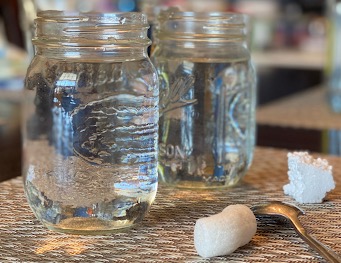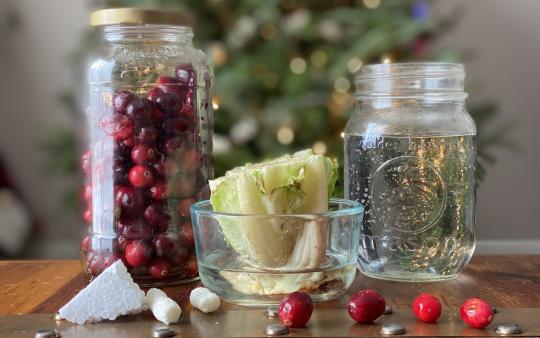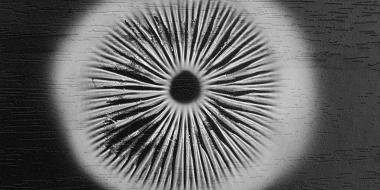3 Sustainability Science Experiments for the Holiday Season
Jessica Purcell/thoughtfullysustainable.com
“The curious world we inhabit is more wonderful than convenient; more beautiful that it is useful; it is more to be admired and enjoyed than used.” - Henry David Thoreau
Are you looking for a way to keep your kids learning over the upcoming holiday break? Here are 3 simple sustainability science experiments that can be done at home with easily accessible items!
In a few simple steps, your learners will confidently be able to:
- Compare and contrast compostable versus traditional packaging
- Grow food from scraps in an effort to fight food waste
- Predict if cranberries float or sink in water and why
Engaging young minds in the scientific process builds critical thinking skills, which are essential in raising scientifically literate children. Ready to start experimenting?
Comparing compostable vs. traditional packing peanuts
With the onslaught of online ordering, we all have a LOT more packaging accumulating in our homes. This simple experiment demonstrates the difference between petroleum-based polystyrene (commonly, yet mistakenly, called styrofoam) and plant-based packaging, using examples of each type, some water and a spoon!
Before we continue, you may be asking yourself, “How can I tell if my packing peanuts are plant-based? Simply dip the end of one packing peanut in water. If it feels sticky and starts to break apart, it’s plant-based. If nothing happens, it’s petroleum-based.
Now that you can tell the difference between plant-based versus petroleum-based packaging, we can start the experiment.

What you’ll need:
- Polystyrene packaging (doesn’t have to be in the traditional “peanut” form; any white, “styrofoam-like” packing material will do!)
- Plant-based packing peanuts
- 2 clear containers
- Water
- Spoon
Instructions:
- Make observations about each type of packaging. Prompt your learners with questions such as, “What color is the packaging? Is it light or heavy?”
- Create a hypothesis about each type of packaging by completing this sentence for each: “If I place the _____________ packaging in water, it will….”
- Fill each container approximately half full of water.
- Place the polystyrene packaging in one container of water and the plant packaging in the other.
- Stir each mixture for approximately 1 minute.
- Observe any changes that occur.
What you will discover is that the petroleum-based packaging does not change, and floats on top of the water, while the plant-based packaging dissolves.
When your learners ask why this happens, explain that the polystyrene packaging is made of oil, and oil and water do not mix, while the plant-based packaging is made of starch, and easily dissolves in water.
To access a free printable to accompany this lesson, click here.
Growing lettuce from scrap
Demonstrating that food waste should be avoided as much as possible is an ongoing theme at our house. Having my kids watch a scrap of lettuce grow into more edible greens creates an excellent lesson in both data collection and data visualization skills, as well as an introduction to plant propagation!

What you’ll need:
- End portion of lettuce stalk, approximately 5-8 cm high
- Shallow dish
- Water
- Ruler
Instructions:
- Place the end of your lettuce stalk in a shallow dish.
- Pour enough water into the dish to create a depth of approximately 1 cm.
- Place the dish containing the food scrap on a sunny windowsill or countertop.
- Create a table with 2 columns: date and vertical growth. Record your starting date on the table and a value of 0 units for the initial vertical growth.
- Watch for growth in the center of the stalk and record the change in vertical growth in cm every other day for 2 weeks.
- Change water every 1-2 days to avoid a slimy buildup on the lettuce stalk. If a slimy film is detected, rinse the stalk in fresh water and change the water in the dish.
- After 2 weeks, create a bar graph with the data collected to visually represent the growth of the lettuce. Conducting this experiment is an excellent way to have meaningful conversations about food waste with your family. Regrowing food scraps is just one of many individual ways to avoid wasting food.
Probe your learners to see if they can come up with other ways to keep edible food from the garbage pail. Planning meals ahead of time, purchasing only what you need, eating your leftovers, freezing food scraps to make soups and composting are all ways to decrease the amount of food that is wasted in your home.
To access a free printable to accompany this lesson, click here.
Determining if cranberries float or sink
Getting kids to confidently work their way through the scientific method can be achieved with this 10-minute experiment, which tests if cranberries can float or sink. Raising scientifically literate thinkers is critical as we prepare our children to enter the world on their own!

What you’ll need:
- A handful of fresh cranberries
- Clear container
- Water
- Knife
Instructions:
- Make observations about the cranberries. Prompt your learners to answer questions such as: What color are the cranberries? What shape are they? Are they hard or soft?
- Make a prediction about the cranberries. Will they float or sink when placed in water? Be sure to emphasize that a prediction (or hypothesis) is an educated guess and that it’s absolutely okay if their guess isn’t correct!
- Test the prediction by dropping a few cranberries in water and observe.
- Ask your learners to come up with a reason why they observed the result they did.
- Cut open a cranberry and allow them to look inside and see if their reasoning was accurate!
Although simple, this science experiment allows your learners to work through the scientific method with confidence.
To access a free printable to accompany this lesson, click here.
Fostering a love of science at a young age also cultivates curiosity in the natural world. This holiday season, enjoy the wonder and beauty of the natural world with the little learners in your life.
For more sustainability science lessons, in English and Spanish, please visit thoughtfullysustainable.com
You may also enjoy: Five Eco-Friendly and Biodegradable Holiday Decoration, How Wild Seeds Disperse, and Spring Into Tree Observation.






